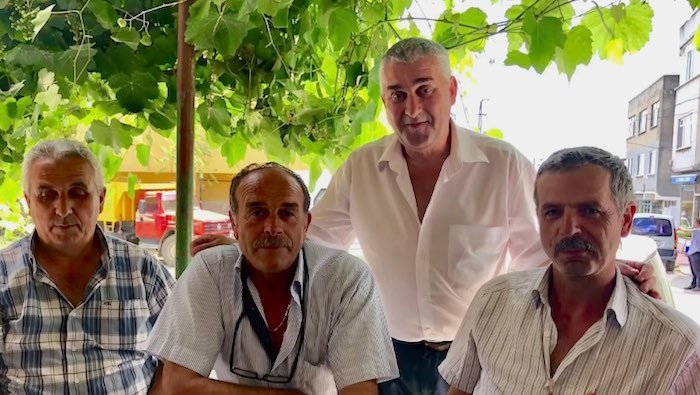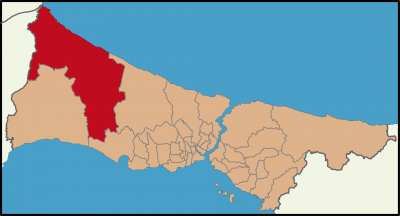Administration
The sancak Kaza-ı Erbaa with the main village Terkos (Grk.: Derkos, Delkos; mod. Durusu) was formed in 1852 and dissolved in 1866; it was formed again in 1870 under the name of Çekmece and added to the Vilâyet Constantinople in 1872. From 1878 it bore the name Çatalca.
Toponym
Çatalca’s ancient Greek name was Ergiske (Ἐργίσκη – Ergískē). According to Suida, this name derives from Ergiscos (Ἐργίσκος), a son of Poseidon through the naiad (nymph) Aba (Ἄβα). In Greek mythology, Aba was a nymph and she is presumed to be a daughter of the river Hebros. The site is now occupied in part by modern Çatalca.
Under Roman rule, Ergiske was named Metrai, Metrae or Metre and was important enough in the Late Roman province of Europa to become a suffragan of its capital Heraclea‘s Metropolitan Archbishop, yet was to fade.
Population
| According to official Ottoman statistics of 1910, the total population of the predominantly Greek sancak comprised 68,840 inhabitants; of these, 18,000 were Turks, 48, 500 Greeks, and 2,340 “others”.[1] |
According to the Ottoman population statistics of 1914, the kaza of Çatalca had a total population of 30,165, consisting of 16,984 Greeks, 13,034 Muslims, 53 Jews, 44 Armenians, 40 Bulgarians and 10 Roma people.[2]
The Diocese of Çatalca comprised 9,005 Greeks in eleven communities.[3]
History
Ergiske/Metrae was an ancient Greek city in Thrace, located in the region of the Propontis.
In the First Balkan War the Bulgarian army had driven the Ottoman forces back from the border, but the Ottoman forces retreated to the prepared positions at Çatalca where on 16–17 November 1912 they defeated the Bulgarians at the “First Battle of Çatalca”. The Çatalca fortifications formed a line across the peninsula, which became the armistice line of 3 December 1912, after Bulgaria decided not to attack Adrianople at that time. Upon expiration of the armistice, on 3 February [O.S. 21 January] 1913, hostilities recommenced and the Second Battle of Çatalca began. It was a series of thrusts and counter-thrusts by both the Ottomans and the Bulgarians and lasted until 3 April 1913. There were a large number of journalists who reported on the military actions at Çatalca, whose accounts provide rich details about this event.
Destruction
“Diocese of Tchataldja [Çatalca]
This diocese was composed of eleven communities and contained a population of 9,005 Greeks. Although they were not forced into exile, they were nevertheless exposed not only to Bulgarian persecution, but to that also of the Turkish element after the retreat of the Bulgarians.
The inhabitants of the communities of this diocese were on the one hand threatened with exile, and on the other had to share in the sufferings of thousands of Christians from the dioceses of Dercos [Derkos] and Tchorlou [Çorlu], to whom they afforded shelter.
At one moment the inhabitants thought they were on the eve of their deportation, because a committee, accompanied by gendarmes, visited their villages and took down the names of the Christian owners of houses, in which they were to accommodate the Turkish refugees. Firing and aggression by night inspired the inhabitants with great fear for their lives, property and honor.
Several Christians were cruelly maltreated and others, among whom were the Vicar of Kalikratia, had to appear before a court martial following certain false accusations brought against them by the gendarmes.”
Excerpted from: Ecumenical Patriarchate: Persecution of the Greeks in Turkey, 1914-1918. Constantinople [London, Printed by the Hesperia Press], 1919, p. 28
1919-1920
Diocese of Metrae
“During the period from the Armistice till lately, anarchy and terror reigned over the entire independent district of Metrae. The activity of the Turkish bands was daily intensified and there was no safety. The coasts of the Euxine from Ascos down to Neohoriou was the landing place for Lazes coming from the Eastern shores and who after being organized by the Metrai constabulary were sent to different places of the vicinity, to practice their criminal designs.
Parallel to this, the Turkish inhabitant’s temperament began to evolve. Their provocations and their menaces increased every day. When ordered by the local authorities to drive away every single Christian out of their villages, the Turks, the peasantry particularly, started executing these orders by night-assaults and by menaces.
Acts of violence by the Turks against our [the Greek] element were on the order of the day, and attempts at murder and slaughter were often noted.
In March, 1919, an inhabitant of ‘St. George’ village was slain by Turks in the wood where he had gone for fuel.
In April, 1919, Constantine Mimicou of Arnaut-keuy [Arnavutköy], coming from Constantinople was cut to pieces by Turks. It must be noted that the Turks of the vicinity were openly armed by the Turkish government and chiefly the Turkish villages, Samlarkeuy [Samlarköy] and Haratsi. Towards the close of the same month, a Greek youth, 17 years of age, was found strangled on the Bouyouk Tchekmedjé [Büyükçekmece] shore, but in spite of the serious grounds for suspicion against the son of Said Agha, a Turkish notable, the authorities took no action whatever on the matter.
On June 1st of the same year, the son of Lazaros, a native of Petrohori, was beaten very hard by two constables who robbed him of all the money and goods he had with himself.
On the 26th of the same month, George Keghasias of Elbasan, was murdered by Turks on his way home to Metrae.
On the same day four Greeks from Arson returning home from Constantinople were robbed by some constables from Bouyouk Tchekmedjé [Büyük Çekmece] and narrowly escaped being murdered by them.
On September 25th of the same year, Turkish constabulary killed a shepherd, named Peter, a native of Loulé-Bourghaz [Lüleburgaz].”
Excerpted from: Ecumenical Patriarchate: The black book of the sufferings of the Greek people in Turkey from the armistice to the end of 1920. Constantinople, 1920, pp. 153f.
Philipp Chrysopoulos: Catalca – The Turkish Town Full of Greek Speakers

“There is a Turkish town called Catalca in the rural district of Istanbul that is full of Greek speakers, many of whom have a distinct northern Greek accent.
A recent video filmed by Constantine Garelas shows a group of Greek-speaking men filled with joy as they meet the Greek visitor to their village. They perceive him as a compatriot who lives on the other side of the border.
The men, who are all over 50 years old, speak with a strange feeling of nostalgia for the land of their ancestors and their roots. Most of them are descendants of the population exchange between Turkey and Greece that took place in 1923, after the Asia Minor Disaster.
Some have never been to Greece, but they like to speak the language. Probably because it is the link with the homeland of their ancestors.
They sing Greek songs with great joy, as if they want to prove to the person holding the camera that despite the nationality written on their ID, they are Hellenes. Or simply because it comes from a soft spot deep in their hearts.
And those who have visited the place their ancestors used to live, speak with pride about the trip to their roots. These are the Greeks at heart in Catalca, Turkey.
Greek-speaking town in Turkey was home to ancient Greek city
Once an ancient Greek city called Ergiske (Εργίσκη), the town is believed to have been settled as early as 450 BC. (…)
The town was settled throughout the Ottoman period and according to the Ottoman Official Statistics of 1910 the majority of the area were Greeks, almost six out of ten residents. (…)
Due to its location on the ridge between the Marmara and the Black Sea and its closeness to Istanbul, Catalca has seen many population movements.
Migrations to and from the area occurred during the Balkan Wars (1912/13) and the First World War (1914-18).
However, the Population Exchange Treaty signed between the Turkish and Greek Governments in January 30, 1923 was the first of its kind in history because it was legalized by international laws, which forced the exchange of population between the two countries.
The most remarkable about the treaty is the main criterion which was exclusively religious. There was no reference to linguistic categories or to ethnic ones.
People were ascribed new identities as either Greek or Turkish merely on the basis of religion.
The majority of the Muslims from Macedonia were Greek-speaking and a considerable proportion of the Greek Orthodox of Central Anatolia spoke Turkish.
“My grandparents came here and spoke only Greek,” notes a resident of Catalca in the video.
Population exchange brought Greek speakers to Turkish town Catalca
The population exchange was seen as an integral part of the nation-building process. Approximately, 1,700,000 people (1,200,000 Orthodox Greeks and 500,000 Muslims) were subjected to the exchange.
The migrants were carried port to port by ships and settled first in temporary refugee camps.
As a result of this mandatory migration, the lives of thousands of people were changed completely.
In reality, they were victims of the treaty on both sides, as they had to rebuild their lives from the beginning.
The exchanged population tried to preserve their identities and cultures of origin homeland while struggling to integrate to the new community.
Prior to the 1923 exchange, Orthodox Greeks and Muslim Turks used to live peacefully together in Catalca.
After the exchange, Muslim people from Grevena, Lagadas, Kilkis, Drama and other cities and towns of Macedonia settled in the residential areas of Catalca, replacing the Greeks who had to abandon their homes.
Today, as can be seen in the video, the Greeks – who are Turkish citizens – speak their language fluently and happily, albeit a northern Greece dialect. Much like the Muslim Greek citizens who live in Western Thrace without forgetting their cultural heritage and religion.
In 2010, a historical building in Catalca was allocated to the Foundation of Lausanne Treaty Emigrants to be used as a Population Exchange Museum.
The museum opened to the public in 20 December 2010 after restoration of the building, with the Çatalca Municipality’s partnership and the support of the Istanbul 2010 European Capital of Culture Agency.”
